Chapter 19.60
ADMINISTRATIVE DESIGN REVIEW (ADR)
Sections:
19.60.020 Chapter application.
19.60.035 Corner lot duplexes.
19.60.040 Design review guidelines.
19.60.050 Minimum design performance standards.
19.60.060 Commercial and business park development design standards.
19.60.070 Industrial development design standards.
19.60.075 Community mixed use district development design standards.
19.60.080 ADR/building permit process.
19.60.110 Maintenance of ADR requirements.
19.60.120 Optional industrial design review guidelines and standards.
19.60.010 Purpose.
The intent of this chapter is to improve the likelihood that developments within commercial, public use/open space, and industrial zoning districts will promote Fife’s vision of maintaining a wholesome, restful and neighborhood-like atmosphere. The inclusion of appropriate design features within a development will facilitate the promotion of a community where residential, commercial, public use/open space and industrial uses can co-exist and flourish. (Ord. 2043 § 1 (Att. C), 2021; Ord. 1584-06 § 3, 2006; Ord. 1317 § 3, 1998).
19.60.020 Chapter application.
In addition to the development standards required elsewhere in this title and the Fife Municipal Code (FMC), this chapter shall apply to:
A. Any corner lot duplex which is constructed or relocated on a lot within the city of Fife. Corner lot duplexes are only subject to the design requirements stipulated in FMC 19.60.035. Exemptions from the requirements due to site-specific constraints and conditions shall be handled administratively under the direction of the community development director and public works director.
B. Any structure within a commercial, public use/open space, mixed use, or industrial zoning district which is constructed, located or relocated on a lot within the city of Fife.
C. Any structure within a commercial, public use/open space, mixed use, or industrial zoning district which is expanded by 50 percent or more in gross floor area after the effective date of the ordinance codified in this title. The requirements of this chapter shall apply to the expanded portion of the structure.
D. When the cumulative gross floor area of expansions after the effective date of the ordinance codified in this title is greater than or equal to 50 percent of the gross floor area existing at time of title adoption, the requirements of this chapter shall apply to the entire expanded portion of the structure since the effective date of the ordinance codified in this title. (Ord. 2043 § 1 (Att. C), 2021; Ord. 1699 § 1, 2009; Ord. 1584-06 § 4, 2006; Ord. 1317 § 3, 1998).
19.60.030 Exemptions.
The following existing and proposed structures and activities are exempt from this chapter:
A. Any building activity that does not add additional height and does not increase a building footprint by more than 1,000 square feet or have a total cost of more than $10,000; or
B. When the total gross floor area of all structures on a lot is 5,000 square feet or less, provided such lot is not abutting a street with a minor arterial classification or greater. (Ord. 1317 § 3, 1998).
19.60.035 Corner lot duplexes.
The following are the minimum design requirements for corner lot duplexes subject to ADR:
A. Building Orientation. Duplexes located on corner lots shall be designed with pedestrian entries located on different street frontages so that the structure is characteristic of a single-family dwelling from each street. Alternatively, there may be a single shared entrance that presents the appearance of one single-family house.
B. Access. Vehicular access shall be located on the lowest classified roadway for corner lots with two street classifications and driveway must be shared. For duplexes fronting on two local access roads, there may be vehicular access and individual driveways for each frontage. The public works director may restrict access to a specific frontage if necessary for public safety. (Ord. 2043 § 1 (Att. C), 2021).
19.60.040 Design review guidelines.
Administrative design review is part of the overall building permit review process. The ADR requires a comprehensive staff review which includes all development regulations within the FMC and the comprehensive plan. All proposals subject to review under this chapter shall follow the design guidelines and standards of this section.
A. Building Design.
1. Community-Oriented Design. The design of buildings should incorporate elements such as architectural details, distinctive color schemes and other features which are sensitive to and enhance the surrounding area and serve to distinguish the complex from other commercial and industrial complexes within the city.
2. Unity of Building Design. All visible sides of a building should incorporate similar design elements, such as surface materials, painting scheme, roof treatment, windows and doors in order to achieve a unity of design.
3. Street Frontage. The sides of a building which face toward a public street should include entrances and windows to provide visual access to the activity within the building.
4. Facing Adjoining Property. The sides of a building which face toward an adjoining property, but not toward a public street, should include elements such as windows, doors, color, texture, landscaping or wall treatment to provide visual interest and prevent the development of a long continuous blank wall.
5. Variation in Design Pattern. Architectural or surface changes in a wall facade or roofline should be varied in order to avoid monotony of design.
6. Multibuilding Complex. All buildings within a multibuilding complex should achieve a unity of design through the use of similar architectural elements, such as roof form, exterior building materials, colors, landscaping and window style.
7. Multitenant Building. Each tenant entrance should be accentuated with similar design elements such as surface materials, windows, awnings, color treatment, roof variation and landscaping.
8. Signs. The color, size, location, lighting and number of signs on-site should not detract from the overall building design. Corporate colors and logos should be taken into consideration during the administrative review.
9. Accessory Structures. Design of all accessory structures should be consistent with the primary building subject to this chapter to achieve a uniformity in design.
B. Site Design.
1. Mount Rainier. To greatest extent practicable, a building design and site layout should take into consideration the preservation of residential views of Mount Rainier.
2. Building as Buffer. In order to more effectively address noise, safety and aesthetic considerations, the proper placement of site features in relation to a building should be reviewed. For example, loading docks, extensive truck circulation areas and stormwater drainage facilities should not be located between a building and a public right-of-way or residential zoning district if adequate space is available elsewhere. (Ord. 1317 § 3, 1998).
19.60.050 Minimum design performance standards.
The following design standards are the minimum requirements necessary for structures subject to an ADR:
A. Building Design.
1. Wall Covering. All nondecorative masonry, concrete or metal walls shall be painted. No bright or brilliant colors are permissible, except as accents. All wall coverings shall be maintained in a presentable state. Long continuous blank walls which are visible from a public right-of-way or residential zoning district shall not be allowed.
2. Metal Exterior. No building wall exterior shall predominantly consist of nondecorative flat or corrugated metal siding or other metallic-type material.
3. Lighting. All building-mounted floodlights shall be shielded from above in such a manner that the bottom edge of the shield shall be at or below the light source.
4. Mechanical Devices. All visible roof-mounted mechanical devices, including communication structures and antennas, shall be set back as far as practicable from public rights-of-way or residential zoning districts. Mechanical equipment less than or equal to 1.5 feet in height above the roof shall be painted a color which blends with the roof structure. Mechanical equipment greater than 1.5 feet above the roof shall be decoratively screened. Required screening for noise impacts shall also be considered for all mechanical equipment.
5. Signs. Each multitenant building shall have an identified wall sign centerline. All wall signs shall be centered along said line. All signs must comply with the provisions of FMC Title 16.
6. Additional provisions for projects within the CMU zone on sites less than 10 acres:
i. Street Facade Transparency. To allow visual access between building interiors and the public sidewalk, at least 60 percent of the wall area of any street-level building facade facing an arterial shall consist of non-obscuring windows and doorways. The requirement is 30 percent for facades along non-arterial frontages.
ii. Primary Building Entries. To promote active, pedestrian streets, there shall be at least one public primary building entrance for each 150 linear feet of building frontage along an arterial.
iii. Canopies Over Sidewalks. All-weather canopies that extend a minimum of five feet from the facade along all portions of buildings that front an arterial shall be provided to promote pedestrian activity.
7. Additional provisions for projects within the CMU zone on sites containing 10 or more acres:
i. Street Facade Transparency. To allow visual access between building interiors and a public sidewalk, at least 40 percent of the wall area of any street-level building facade within 30 feet of an arterial and at least 60 percent of the wall area of any street-level building facade fronting any other street shall consist of non-obscuring windows and doorways.
ii. Canopies Over Sidewalks. All-weather canopies that extend a minimum of five feet from the facade along all portions of buildings that are sited within five feet of an arterial right-of-way shall be provided to promote pedestrian activity.
B. Site Design.
1. Residential Views of Mount Rainier. To the greatest extent practicable, proposed development shall be designed and located to avoid blocking the view of Mount Rainier from existing residential uses or from residential zoning districts.
2. Building as Buffer. Where feasible and appropriate, a building shall be located between a public right-of-way and loading and truck circulation areas, outside storage areas, stormwater detention facilities and biofiltration swales. (Ord. 1777 § 1 (Exh. A), 2012; Ord. 1654-07 § 3, 2007; Ord. 1317 § 3, 1998).
19.60.060 Commercial and business park development design standards.
In addition to the design standards identified in FMC 19.60.050, the following standards are required for commercial development in any zoning district and all development within the business park district:
A. Street/Residential Zoning District Frontage. If any wall or portion of a wall faces and is visible from a public right-of-way and is within 150 feet of such right-of-way, or a residential zoning district and is within 300 feet of such zoning district, then at least two design features identified in subsection C of this section covering at least 50 percent of the wall area shall be incorporated into an overall design concept. The 150-foot and 300-foot distance criteria is not limited to contiguous property.
B. Street/Residential Zoning District Visibility. Any wall which does not come under design review in subsection A of this section, but which is predominantly visible from a public right-of-way or residential zoning district, shall utilize at least one design feature identified in subsection C of this section. The selected design feature shall cover at least 20 percent of the wall area and shall be incorporated into an overall design concept. This subsection does not apply to walls which are predominantly visible from elevated streets or areas.
C. Design Feature List. The design feature list consists of:
1. Windows;
2. Pillars or columns;
3. Awnings;
4. Decorative and distinguishable etchings or reliefs;
5. Shifts in wall plane to include recesses, protrusions, planters or overhangs (minimum three feet);
6. Vertical trellis with climbing vines or plant material adjacent to wall;
7. Evergreen and/or columnar trees planted adjacent to wall;
8. Use of distinguishably different building materials, wall textures and/or paint color in the exterior treatment of a blank wall area;
9. Sculptures and/or fountain adjacent to the wall. Wall area behind water plume will count toward wall coverage percentage.
Signs do not count as a design feature and are subtracted from coverage credit. (Ord. 1404 § 2(Exh. C § 7), 2000; Ord. 1317 § 3, 1998).
19.60.070 Industrial development design standards.
In addition to the design standards in FMC 19.60.050, the following standards are required for industrial development:
A. Street/Residential Zoning District Frontage. Any wall or portion of a wall which faces and is visible from a public right-of-way and is within 150 feet of such right-of-way, or a residential zoning district and is within 300 feet of a residential zoning district, shall use design features from the industrial design menu in subsection D of this section. The design concept shall incorporate a combination of three design features which shall equal or exceed five design points. The 150-foot and 300-foot distance criteria is not limited to contiguous property.
B. Street/Residential Zoning District Visibility. Any wall which does not come under design review in subsection A of this section, but which is predominantly visible from a public right-of-way or residential zoning district shall use at least one design feature below which shall be incorporated into an overall design concept. This subsection does not include walls which are predominantly visible from elevated streets or areas.
C. Required Buffer Yard D or E. For an industrial structure subject to buffer yard D or E, that portion of the structure subject to ADR at a height less than or equal to the combined height of the berm and fence shall be given three points of coverage credit for evergreen and/or columnar trees as identified in subsection D of this section. The remaining coverage credit requirement shall be located above the height of the combined berm and fence. The wall facing the buffer yard is exempt from any further coverage requirements if less than 40 percent of the wall surface is located at a height above the top of the berm and fence.
D. Industrial Design Standard Menu. Select three features that will add up to a minimum of five points. The points are primarily based on the area of coverage. Coverage credit may not overlap unless expressly permitted below. Signs do not count as design feature and are subtracted from coverage credit.
|
INDUSTRIAL DESIGN STANDARD MENU |
|||
|
Design Feature |
Design Coverage Credit |
Wall % |
Pts. |
|
Windows |
Square footage of windows. |
4 – 7 |
1 |
|
Paint/texture Distinguishably different building materials, wall textures and/or paint color. Paint/texture pattern shall vary across wall. |
Square footage of paint/texture. Window area not used for coverage credit elsewhere may be counted as paint/texture. |
10 – 19 |
1 |
|
Evergreen or columnar trees Minimum 6' evergreen and/or 2" caliper columnar trees. |
Square footage = [(1.5 x planting height) x (15' width)]. Except for significant wall plane shifts, credit may overlap another feature’s credit. |
10 – 19 |
1 |
|
Significant wall plane shift A recess, protrusion or overhang from primary wall plane. Minimum depth =10', maximum depth =20', or 20% of facade length up to maximum of 40' for facades > 100 feet in length. |
2 significant wall plane shifts. 1 significant wall plane shift. 50% credit overlap with other feature allowed. |
≥ 15 each |
2 |
|
Pillars or columns |
Square footage behind and between closely spaced pillars or columns. |
10 – 19 |
1 |
|
Etchings and/or reliefs Decorative and distinguishable etchings and/or reliefs. |
Square footage behind and between closely spaced etchings and/or reliefs. Solitary line etchings given a 1' wide band as credit. |
≥ 10 |
1 |
|
Minor wall plane shifts (minimum 3' depth). Include recesses, protrusions, planters and/or overhangs. |
Square footage of plane shifts. No credit if using significant wall plane shifts for credit above. |
≥ 10 |
1 |
|
Vertical trellis Vertical trellis with climbing vines or plant material. |
Square footage behind plant material. |
≥ 10 |
1 |
(Ord. 1317 § 3, 1998).
19.60.075 Community mixed use district development design standards.
In addition to the design standards identified in FMC 19.60.050, the following standards are required for development within the community mixed use district:
A. Interconnectedness. Driveway and sidewalk connections to and through the development to adjoining streets, bus stops, designated urban trails, and properties shall be provided where access exists or reasonable connections are possible. If a parking lot lies between the building entry and an adjacent public street, a pedestrian walkway at least six feet wide shall be provided between them. In all other cases, on-site sidewalks shall have a passable width of at least four feet. All crossings of vehicular travel lanes shall be clearly marked.
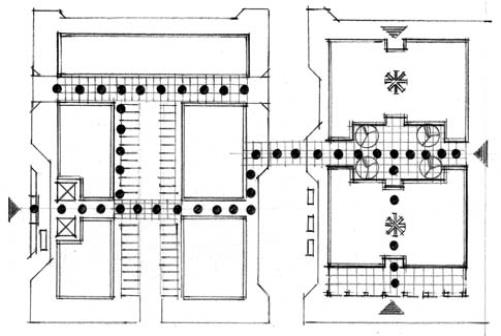
Figure 1: Shows vehicle and pedestrian sidewalk access.
B. Pedestrian Amenities. Pedestrian amenities shall be provided in places where people typically gather, including but not limited to transit stops, building entrances, public sidewalks, or street corners. These spaces shall include but not be limited to seating, some type of landscaping and at least three of the following examples and shall have design consistency and placement with the surrounding area:
1. Patterned materials on walkways;
2. Transit shelters;
3. Trash receptacles;
4. Drinking fountains;
5. Fountains, pedestrian artwork, sculptures, mobiles, kiosks;
6. Street trees in decorative grates, flower boxes, or container landscaping in alleys;
7. Street vendor stations where appropriate;
8. Benches shall be placed every 200 feet maximum distance from the last bench and trash receptacle. Some variation may be permitted in instances where a natural gathering place is being proposed. For instance, a corner lot, transit stop, or the like.
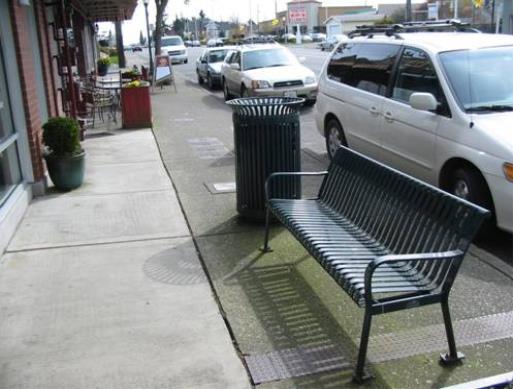 Figure 2: Shows example of pedestrian amenities.
Figure 2: Shows example of pedestrian amenities.
C. Pedestrian lighting, light bollards, or alley lighting is required in pedestrian pathway or walkway areas. All display and flood lighting shall be constructed so as to not illuminate the surrounding properties or adjoining public right-of-way in accordance with FMC 19.68.030(G).
D. Facade and Roofline Variation. Architectural or surface changes in a wall facade or roofline shall be varied in order to avoid monotony of design.
E. Building Modulation, Articulation, and Pedestrian Views. Facade design features shall be incorporated to reduce the apparent size of large buildings. Design elements shall include, but are not limited to: facade modulation, cornices, window patterns, plazas, porches, patios, decks, covered entries, balconies, bay windows, dormers, stepped roofs, gables or other roof elements, a variety of cladding materials, lighting fixtures, trellises, trees or other landscape features, and multiple paint colors and building materials.
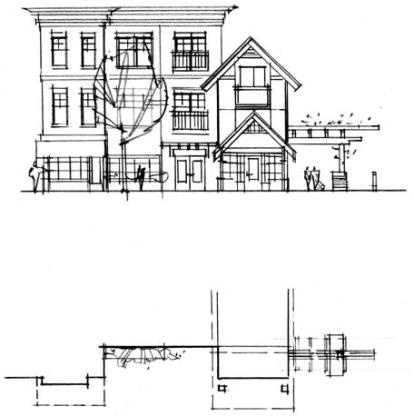 Figure 3: Shows examples of windows, design fluctuations to accentuate human scale design.
Figure 3: Shows examples of windows, design fluctuations to accentuate human scale design.
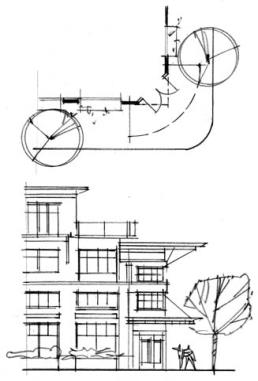
Figure 4: Shows building modulation and corner lot appearance.
F. Window Design. Windows should provide relief, detail, and variation to building facades and shall be similar to the character of the structure.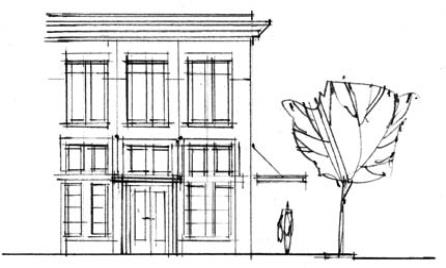
Figure 5: Shows an example of awning projection.
G. Design Variation. Buildings should have a varied visual identity from all sides visible to the general public, except building walls adjacent to alleys in the community mixed use district. Buildings should present a comparable level of quality of materials, detailing and fenestration.
H. Buildings shall use materials with texture and pattern (such as brick, stone or wood) on exterior building walls and large surfaces.
1. Avoid large expanses of highly tinted or mirrored glass.
2. Do not use highly reflective exterior materials (except glazing) where glare would affect nearby buildings or traffic.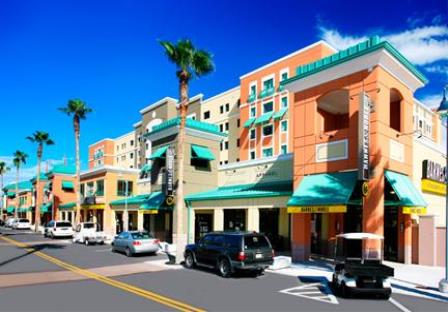
Figure 6: Shows example of a concrete tilt up that meets some of the requirements.
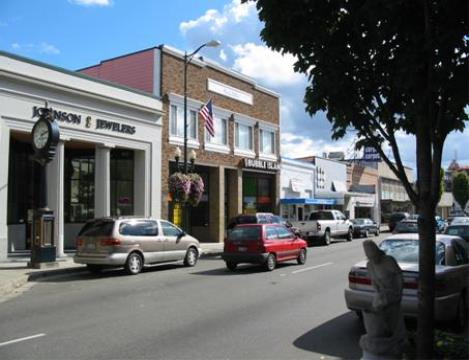 Figure 7: Shows example for roof line requirements and approved patterns with texture as described above.
Figure 7: Shows example for roof line requirements and approved patterns with texture as described above.
I. Parking Structure Design. Vehicle entries to garages shall be recessed at least six feet from the street facade plane. At least 60 percent of the street facade between two and eight feet above the sidewalk shall have at least one of the treatments listed below.
1. Transparent windows (with clear or lightly tinted glass) where pedestrian-oriented businesses are located along the facade of the parking structure; or
2. Display windows; or
3. Art or architectural treatment such as sculpture, mosaic, glass block, opaque art glass, relief art work, or similar features; or
4. Decorative metal grille work or similar detailing which provides texture and covers the parking structure opening; or
5. Vertical trellis or other landscaping or pedestrian plaza area.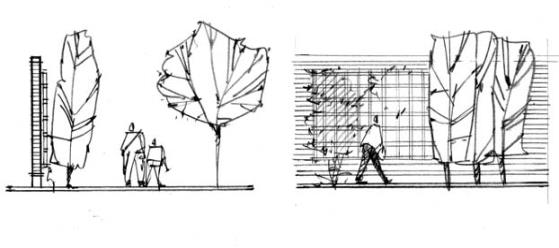
Figure 8: Shows examples of how trees along with lattice can break up the appearance of a blank wall.
J. Bioswales. When bioswales are used, biofiltration swales and ponds shall be integrated into the overall site design. Methods of filtration are listed below in order of preference:
1. Locate biofiltration swales, ponds, or other approved biofiltration systems as part of a landscape screen. Trees may be planted near the grass swale as long as they do not substantially shade the grass within the swale. The swale or pond should be designed so it does not impede pedestrian circulation or shared parking between two or more properties;
2. Where topography is favorable, locate the biofiltration swale, wet pond, or other approved biofiltration system within the paved parking or service area. The swale or pond should be landscaped as part of the required internal parking lot landscaping and oriented so it does not impede pedestrian circulation;
3. Locate the swale in areas where the swale may be used for recreation or similar activities that do not unreasonably reduce the swale’s ability to function properly. Incorporate landscaping and screening to visually enhance the swale without reducing maintainability and sun exposure;
4. The incorporation of screening elements and/or landscaping into biofiltration swale designs is encouraged if the biofiltration swale is located and/or designed as a positive landscaping feature with approved design and plant materials. Where appropriate, shade tolerant plants should be used. It may be counted as part of the required site landscaping;
5. Compensatory storage areas are preferred to be underground; if not, those areas shall follow the same design principles as biofiltration swales;
6. Bioswales that include features as described in this subsection may receive a reduction in their green factor by .05.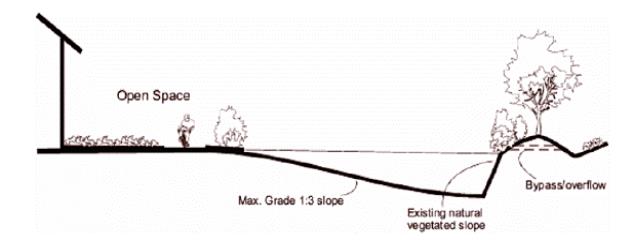
Figure 9: Shows examples of how the swale can be integrated into site design plan.
K. Street Corners. In order to create and preserve visual images for identification and spatial reference at street corners; to enhance the pedestrian environment at street corners; and to create visual interest and increased activity at street corners, all development proposals for street corner sites shall include at least one of the design treatments described below (in order of preference):
1. Provide pedestrian-oriented space at the corner leading directly to a building entry or entries;
2. Locate a building towards the street corner (within 15 feet of corners’ property line).
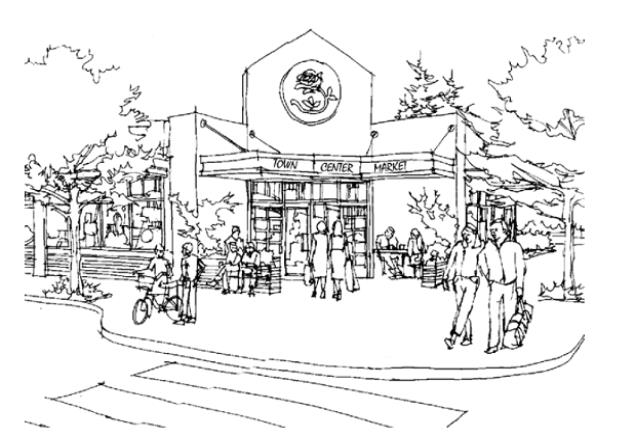 Figure 10: This example includes both a building located towards the street corner and a small pedestrian-oriented space.
Figure 10: This example includes both a building located towards the street corner and a small pedestrian-oriented space.
L. Crosswalks. When crosswalks are required, they should incorporate pedestrian-oriented elements, including but not limited to:
1. Raised walk path;
2. Decorative lighting or ground-type lighting;
3. Decorative masonry, concrete, or the like;
4. Plants or vines along awnings.
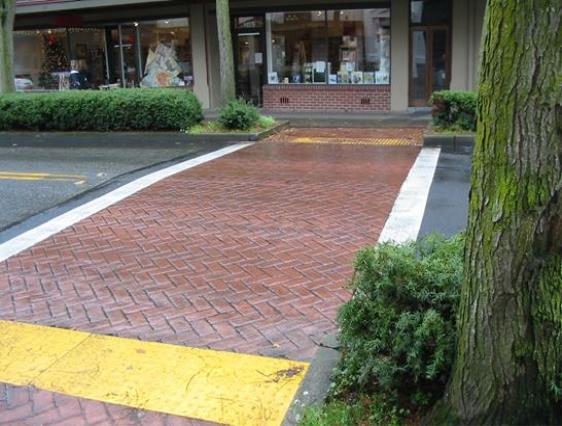 Figure 11: Shows an example of a pedestrian-oriented crosswalk.
Figure 11: Shows an example of a pedestrian-oriented crosswalk.
M. Additional Front Yard Setback. Additional front yard setback may be granted by the community development director for developments in order to provide some outdoor activities that include sidewalk sales or dining areas. Additional front yard setback shall not be granted for parking, stormwater, or additional landscaping. Requirements for additional setback shall include:
1. Provided one additional item from subsection (B) of this section.
2. Additional setback is designed to provide a gathering place. For example: outdoor reading area, dining area, sidewalk sales (see event permit requirements of Chapter 10.32 FMC).
3. Dining and gathering areas may be covered.
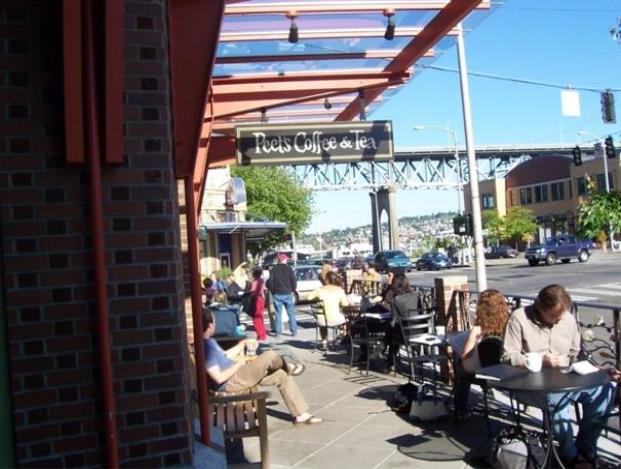 Figure 12: Shows an example of additional front yard setback to accommodate dining area or sales display.
Figure 12: Shows an example of additional front yard setback to accommodate dining area or sales display.
N. Pedestrian Art. Provide visual stimulation along pedestrian paths to add to the community experience; developments should include art within the public realm that is pleasing to the eye, not offensive, and conforms to intent. Pedestrian art can be supplemented toward the requirements in subsection (B) of this section. Pedestrian art can include but is not limited to:
1. Statues or monument type art work;
2. Sidewalk art;
3. Decorative window design (permanent);
4. Street clocks.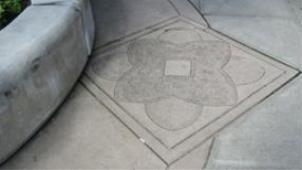
Figure 13: Example of sidewalk art.
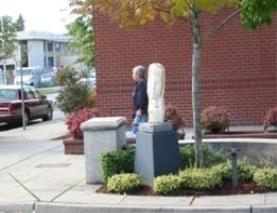 Figure 14: Example of a statue or monument art work.
Figure 14: Example of a statue or monument art work.
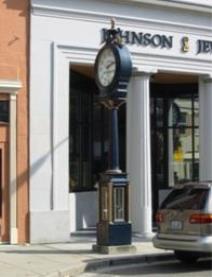
Figure 15: Example of a street clock.
O. Curb Cut Minimization. Curb cuts tend to increase pedestrian exposure to moving vehicles, limit opportunities for landscaping and street trees, eliminate on-street parking spaces, and prohibit uses which promote pedestrian interaction. Vehicle access is least preferred on 20th Street East. Developments shall:
1. Minimize the number of curb cuts and locate them away from street intersections;
2. Minimize the width of curb cut, driveway, and garage opening;
3. To extent practical, share driveway with an adjacent property owner;
4. Provide sufficient queuing space on site.
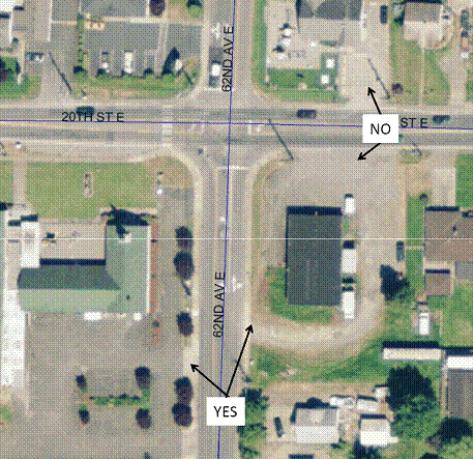 Figure 16: Example of curb cut placement.
Figure 16: Example of curb cut placement.
(Ord. 1699 § 2, 2009).
19.60.080 ADR/building permit process.
The ADR shall be incorporated into the building permit process. A building permit application for a structure subject to ADR shall include any required forms or information which the director indicates is necessary in order to adequately complete the building permit review process. A building permit application subject to the ADR requirements shall include a brief written description of how the proposed structure, structure location and site design meet the criteria listed in FMC 19.60.050. The building permit subject to ADR shall include the following items:
A. Facade Plans. Two full-sized and one reduced set of scaled or dimensioned facade plans for each wall that is subject to FMC 19.60.060 or 19.60.070. The plans shall indicate which features are being utilized to meet the ADR requirements. The wall area covered by each design feature shall be indicated on the plans. Design details such as colors, material, textures and vegetation type shall be identified. For multitenant buildings, a wall sign centerline shall be indicated.
B. Exterior Mechanical Device Screening Plans. All proposed exterior mechanical devices, including roof-mounted equipment and proposed screening, shall be identified on the architectural and mechanical plans. In addition to architectural and mechanical plans, two sets of plans of any proposed screening design shall be submitted with the ADR application. When mechanical plans are submitted without a corresponding building permit application, the location of all exterior and roof-mounted mechanical devices shall be subject to the requirements of this chapter.
C. Coordinated Site Design Plan. Two sets of a coordinated site design plan are required. The coordinated site design plan shall include the location of proposed parking and landscaping areas and the building footprint. The review development within the community mixed use district will be most beneficial if the following items are also included in the site plan design.
1. Site layout;
2. Pedestrian, bicycle and vehicular circulation on site and in relation to connecting walks and streets;
3. Building elevations;
4. Landscaping in concept and general material types; and
5. Storm drainage system concept.
The applicant may combine the required ADR submittals with other required permit submittals if the combined plans will simplify the building permit review process. (Ord. 1699 § 3, 2009; Ord. 1317 § 3, 1998).
19.60.090 Optional planning commission design review.
Repealed by Ord. 1912. (Ord. 1317 § 3, 1998).
19.60.100 ADR modification.
The design review portion of a building permit approved by the director or the planning commission may be modified. Modifications to a design review plan approved by the director shall be reviewed by the director. Modifications to a design review plan approved by the planning commission shall be reviewed by the planning commission.
A. Application Procedure. A written modification request describing in detail the reason and scope of the proposed changes and two sets of the revised plans must be submitted to the community development department.
B. ADR Plan Modification Exemption. The director may determine that a modification to any previously approved design review plan is exempt from further review; provided, that the following criteria are met:
1. The proposal does not result in any adverse impact to property within the vicinity;
2. The proposal is consistent with the purpose and intent of the original approval;
3. The proposal complies with the FMC and the comprehensive plan;
4. The proposal does not add more than 20 percent gross floor area to the existing development; and
5. If an addition or expansion has been approved within the preceding 24-month period, the cumulative additions will not exceed 20 percent of the gross floor area.
C. The director may impose conditions on the modification exemption to ensure that the intent and conditions of the original building permit approval are met. (Ord. 1317 § 3, 1998).
19.60.110 Maintenance of ADR requirements.
The ADR features shall be permanently maintained for the duration of the development’s existence. Materials and painted areas which are faded, peeling and/or chipped shall be repainted or replaced. Landscaping areas shall be maintained in a neat and healthy manner. Trees, shrubs and groundcover which have died shall be replaced with a similar type and size of plant material. See Chapter 19.64 FMC for significant tree replacement ratios. (Ord. 1317 § 3, 1998).
19.60.120 Optional industrial design review guidelines and standards.
Industrial buildings within the industrial district may be exempt from the building design guidelines and standards with the use of site-obscuring landscaping. See Chapter 19.64 FMC for the specific landscaping requirements for this option. (Ord. 1317 § 3, 1998).


